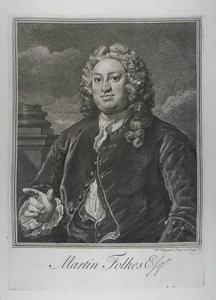| Method | Copper engraving and etching |
| Artist | William Hogarth |
| Published | Wm. Hogarth Pinxt. et Sculpt. 1742. [J & J Boydell c.1795] |
| Dimensions | Image 281 x 227 mm, Plate 338 x 238 mm, Sheet 588 x 440 mm |
| Notes |
A half-length portrait of Martin Folkes (1690-1754), after the painting Hogarth executed in 1741 for the Royal Society. He wears a wig and coat, and gestures with his right hand. Folkes was a British antiquarian, mathematician, and astronomer. An alumnus of Clare College Cambridge, Folkes was such a gifted mathematician that he was elected to the Royal Society at age twenty-three. He served as a vice-president of the Society under Sir Isaac Newton, and, eventually became President in his own right in 1741, having previously been defeated for the position by Sir Hans Sloane following the death of Newton in 1727. Folkes, like Hogarth, was a prominent Freemason and a Governor of the Foundling Hospital. According to his fellow antiquary, William Stukeley, Folkes was a notorious atheist and the progenitor of an 'Infidel Club,' whose mission it was to derail any inclusion of spiritual matters in the debates of the Royal Society. Folkes also served as President for the Society of Antiquaries from 1749 to 1754, contributing many papers of numismatic enquiry, and some 'Observations on the Trajan and Antonine Pillars at Rome.' His Grand Tour to Italy, undertaken in 1733, is likely alluded to in Hogarth's portrait by the inclusion of the broken column base to the left of the scene. The inscription below reads: 'Martin Folkes Esqr.' William Hogarth (1697 - 1764) was born in London, the son of an unsuccessful schoolmaster and writer from Westmoreland. After apprenticeship to a goldsmith, he began to produce his own engraved designs in about 1710. He later took up oil painting, starting with small portrait groups called conversation pieces. He went on to create a series of paintings satirising contemporary customs, but based on earlier Italian prints, of which the first was The Harlot's Progress (1731), and perhaps the most famous The Rake's Progress. His engravings were so plagiarised that he lobbied for the Copyright Act of 1735, commonly referred to as 'Hogarth's Act,' as a protection for writers and artists. During the 1730s Hogarth also developed into an original painter of life-sized portraits, and created the first of several history paintings in the grand manner. Paulson 154 iv/iv, O'Donoghue 2 Condition: Excellent impression with full margins. Light foxing and manuscript number to margin, not affecting image or plate. Small puncture to bottom margin, not affecting image or plate. |
| Framing | unmounted |
| Price | £70.00 |
| Stock ID | 38038 |

